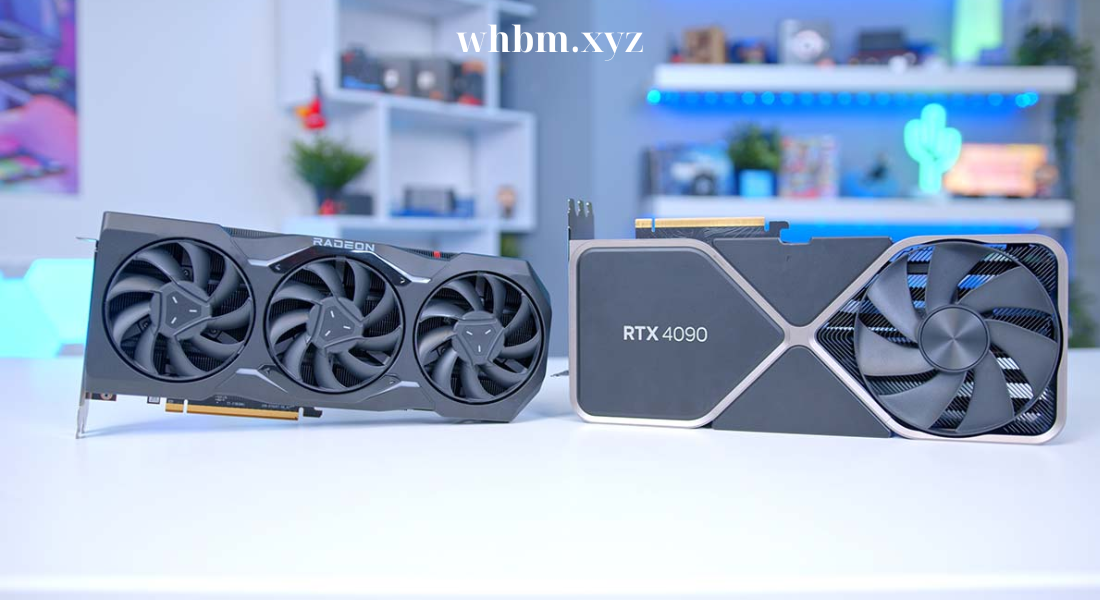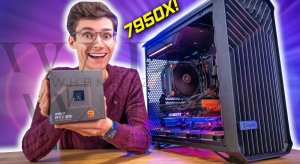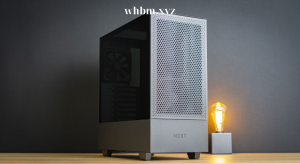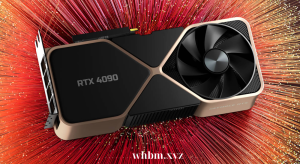As two of the most powerful GPUs on the market, the AMD RX 7900 XTX and NVIDIA RTX 4090 represent the pinnacle of performance in gaming, content creation, and AI-driven applications. Each offers a unique set of features and performance capabilities, targeting enthusiasts and professionals who want the very best. In this article, we’ll dive into the RX 7900 XTX vs. NVIDIA RTX 4090, comparing their specs, performance, power efficiency, and value to help you determine which card is the best fit for your needs.
Architecture Overview: RX 7900 XTX vs. NVIDIA RTX 4090
The RX 7900 XTX is built on AMD’s RDNA 3 architecture, which uses a chiplet design—a first for GPUs—that aims to increase efficiency and reduce production costs while boosting performance. The RDNA 3 architecture features advanced ray tracing and improved compute units for superior rendering and gaming performance.
On the other hand, the NVIDIA RTX 4090 is based on NVIDIA’s Ada Lovelace architecture, manufactured on TSMC’s 4nm process. Ada Lovelace brings third-generation RT cores and fourth-generation Tensor Cores, along with DLSS 3.0, NVIDIA’s advanced AI upscaling technology. When comparing the RX 7900 XTX vs. NVIDIA RTX 4090 in terms of architecture, both cards showcase significant advancements in GPU technology, though NVIDIA’s Ada Lovelace leans more on AI-driven enhancements.
Core Specs: RX 7900 XTX vs. NVIDIA RTX 4090
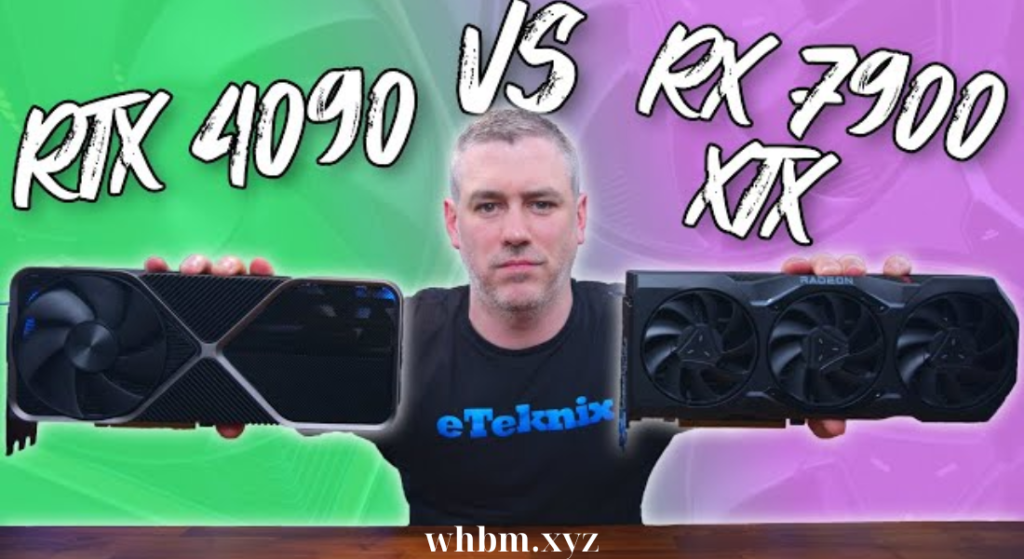
The RX 7900 XTX and NVIDIA RTX 4090 feature impressive specifications, but their architectural approaches and core designs highlight their distinct strategies:
RX 7900 XTX:
- Compute Units: 96, offering extensive parallel processing power
- Ray Accelerators: 96, enabling efficient ray tracing
- Clock Speeds: Boosts up to 2.5 GHz
- Memory: 24GB GDDR6 with a 384-bit memory bus
- Memory Bandwidth: Up to 960 GB/s, which is robust for high-resolution gaming
- TDP: 355W
NVIDIA RTX 4090:
- CUDA Cores: 16,384, significantly more processing cores for handling complex tasks
- RT Cores: Third-generation RT cores, improving real-time ray tracing
- Clock Speeds: Boosts up to 2.52 GHz
- Memory: 24GB GDDR6X with a 384-bit memory bus
- Memory Bandwidth: 1 TB/s, making it highly efficient for resource-intensive applications
- TDP: 450W
When looking at the RX 7900 XTX vs. NVIDIA RTX 4090 in terms of specs, the RTX 4090 takes the lead in raw processing power with its high CUDA core count and faster memory bandwidth, which can be a deciding factor for those needing peak performance in demanding applications. However, AMD’s RX 7900 XTX offers a power-efficient alternative that doesn’t compromise on high-end performance, making it an excellent choice for gamers and creators who prioritize energy efficiency.
Gaming Performance: RX 7900 XTX vs. NVIDIA RTX 4090
Gaming performance is one of the most critical factors in choosing between the RX 7900 XTX vs. NVIDIA RTX 4090. Both cards excel in delivering ultra-high-resolution gameplay, but they differ in handling 4K, 8K, and ray-traced environments.
4K Gaming
For 4K gaming, both GPUs perform exceptionally well. In games like Cyberpunk 2077, Red Dead Redemption 2, and Forza Horizon 5, the RTX 4090 delivers slightly higher frame rates, thanks to its greater CUDA core count and faster memory bandwidth. However, the RX 7900 XTX also achieves impressive performance at 4K, maintaining high frame rates and stability in most AAA titles.
According to benchmarks, the NVIDIA RTX 4090 often outperforms the RX 7900 XTX by around 10-20% in 4K gaming, especially when ray tracing is enabled. For gamers who prioritize absolute maximum performance in 4K with all settings at ultra, the RTX 4090 may be the preferred choice.
Ray Tracing Performance
When comparing RX 7900 XTX vs. NVIDIA RTX 4090 in terms of ray tracing, the RTX 4090 stands out, largely due to its advanced RT cores and DLSS 3.0 support. NVIDIA’s third-generation RT cores deliver superior ray tracing, producing more accurate reflections, shadows, and lighting effects with minimal performance loss. DLSS 3.0 further enhances this experience by using AI to generate additional frames, boosting frame rates without compromising visual fidelity.
While the RX 7900 XTX includes robust ray tracing capabilities with its 96 ray accelerators, it does not quite reach the same level of efficiency as the RTX 4090 in ray-traced games. However, for games where ray tracing isn’t the primary focus, the RX 7900 XTX provides comparable performance at a more affordable price.
8K Gaming
8K gaming is a niche, but for those interested in future-proofing their setup, the RTX 4090 offers a substantial advantage. Its high memory bandwidth and DLSS 3.0 make 8K gaming more feasible, even in graphically demanding titles. The RX 7900 XTX can handle some 8K scenarios, but without NVIDIA’s AI-based DLSS, it struggles to maintain high frame rates in comparison to the RTX 4090. If 8K gaming or 8K content creation is a priority, the RTX 4090 is the clear winner.
Content Creation: RX 7900 XTX vs. NVIDIA RTX 4090
Beyond gaming, the RX 7900 XTX vs. NVIDIA RTX 4090 comparison shows that both GPUs are excellent for content creators, though their strengths vary in specific areas.
The RTX 4090, with its higher CUDA core count and Tensor Cores, is well-suited for rendering, video editing, and AI-driven applications. Programs like Blender, Adobe Premiere Pro, and DaVinci Resolve benefit significantly from the RTX 4090’s processing power, reducing render times and allowing for real-time previews even in high-resolution formats.
The RX 7900 XTX, while slightly less powerful in raw compute capabilities, performs admirably in tasks like 3D rendering, video editing, and multitasking. Its 24GB of GDDR6 memory and efficient power consumption make it a valuable choice for creators who don’t require the absolute highest performance but still want excellent efficiency and stability.
Power Efficiency: RX 7900 XTX vs. NVIDIA RTX 4090
Power consumption is an important factor, especially for users who plan to run their systems for extended periods. When evaluating RX 7900 XTX vs. NVIDIA RTX 4090 in terms of power efficiency, the RX 7900 XTX has a clear advantage with a TDP of 355W compared to the RTX 4090’s 450W.
The RX 7900 XTX is more power-efficient, which translates to lower energy costs and reduced heat generation. For those who value energy savings and have environmental considerations, the RX 7900 XTX offers a strong performance-per-watt ratio, making it an appealing choice for sustainable, high-performance gaming.
Pricing and Value: RX 7900 XTX vs. NVIDIA RTX 4090
Pricing plays a significant role in the RX 7900 XTX vs. NVIDIA RTX 4090 comparison. The RTX 4090’s premium price reflects its top-tier specs and features, but it may be out of reach for users on a tighter budget. The RX 7900 XTX, on the other hand, offers high-end performance at a more competitive price, making it a compelling option for gamers and creators who want excellent performance without overspending.
The RX 7900 XTX typically comes in at a significantly lower price than the RTX 4090, offering an impressive value proposition for those who don’t require the absolute peak performance of NVIDIA’s flagship card. For users seeking the best bang for their buck, the RX 7900 XTX delivers strong performance at a reasonable price.
Future-Proofing and Software Support
When choosing between RX 7900 XTX vs. NVIDIA RTX 4090, consider future-proofing and software compatibility. The RTX 4090 benefits from DLSS 3.0, which enhances performance and image quality in supported games, as well as frequent driver updates optimized for the latest applications. NVIDIA’s deep integration with industry-standard software gives it an edge for professionals who rely on specific applications.
AMD’s RX 7900 XTX, meanwhile, offers excellent long-term potential with RDNA 3’s efficient architecture and support for the latest DirectX 12 Ultimate features. AMD is also investing in FSR (FidelityFX Super Resolution), an alternative to DLSS that provides performance boosts in compatible titles. Though DLSS 3.0 is more advanced, FSR continues to improve, making the RX 7900 XTX a future-ready choice for AMD users.
RX 7900 XTX vs. NVIDIA RTX 4090: Final Verdict
In the RX 7900 XTX vs. NVIDIA RTX 4090 showdown, both GPUs offer compelling benefits based on the user’s needs:
- For absolute performance in gaming and content creation, the NVIDIA RTX 4090 is the best choice. Its high CUDA core count, advanced ray tracing with third-generation RT cores, and AI-powered DLSS 3.0 provide an unmatched experience, particularly in 4K and 8K gaming, as well as professional applications requiring heavy rendering or AI processing. For users who want the most powerful GPU available with future-proof capabilities, the RTX 4090 stands out, albeit at a premium price.
- For high-performance value, the RX 7900 XTX offers excellent specs and efficiency, especially considering its more accessible price. While it might fall slightly behind the RTX 4090 in extreme scenarios like intensive ray tracing and 8K gaming, it provides outstanding performance in 4K gaming and creative workflows. The RX 7900 XTX is ideal for users seeking top-tier graphics without reaching the price ceiling of NVIDIA’s flagship. Its efficient architecture and competitive pricing make it a solid choice for those looking for a high-performance GPU with strong power efficiency.
Choosing Based on Use Case: RX 7900 XTX vs. NVIDIA RTX 4090
- Gamers: For gaming enthusiasts focused on ultra-high resolution and maximum graphical fidelity, the NVIDIA RTX 4090 offers peak performance, especially in ray-traced games and 8K gaming. However, for users satisfied with high frame rates at 4K without prioritizing ray tracing, the RX 7900 XTX provides a competitive and cost-effective solution.
- Content Creators: For creators who work with video editing, 3D modeling, and rendering, the RTX 4090’s enhanced CUDA core count and DLSS 3.0 support can reduce render times and increase efficiency. However, the RX 7900 XTX also performs well in creative applications, providing more than enough power for many demanding tasks, making it a budget-friendly option for creators who don’t need the absolute highest performance.
- Professionals and AI Developers: The NVIDIA RTX 4090’s advanced Tensor Cores and ray tracing cores make it ideal for professionals in AI and machine learning. Its compatibility with various industry-standard applications and consistent driver support gives it an edge for those in fields reliant on GPU-accelerated processing.
Conclusion: RX 7900 XTX vs. NVIDIA RTX 4090 – Which One Is Right for You?
The RX 7900 XTX and NVIDIA RTX 4090 are both powerhouse GPUs that cater to the high-performance market. Ultimately, the choice between them depends on the user’s priorities and budget. The NVIDIA RTX 4090 is the right choice for those who want unparalleled performance in every aspect, from gaming to professional tasks. On the other hand, the AMD RX 7900 XTX offers competitive performance at a lower price, making it ideal for users who seek powerful graphics without overspending.
In conclusion, both GPUs excel in their own ways, making each a worthy choice in the high-end GPU market. Whether you prioritize maximum power or value for money, the RX 7900 XTX vs. NVIDIA RTX 4090 comparison provides options for every high-performance enthusiast.
